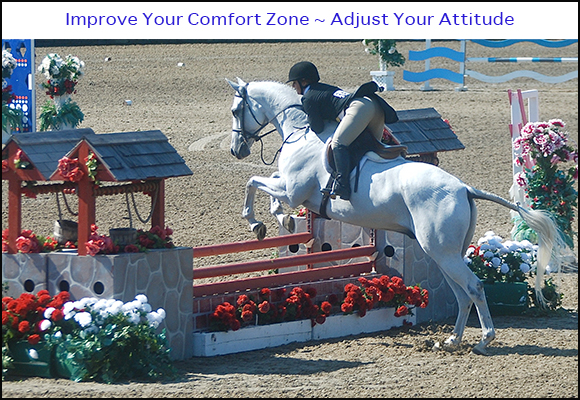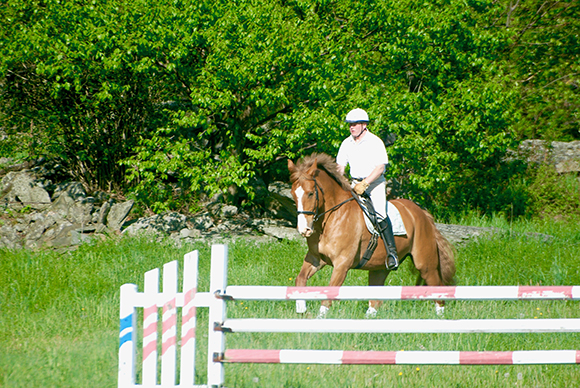Improve Your Comfort Zone ~ Adjust Your Attitude
By Nikki Alvin-Smith

Attitude in riding and indeed in life truly is everything. Many riders unnecessarily stress, become fearful or simply block their way to attaining their riding goals by exhibiting a poor attitude. How to fix it?
Start out by writing down a list of goals. It is important to write it because this way the left side of your brain is being activated and you will retain the knowledge. Be sure you write each goal in a positive language and in the present tense e.g. ‘I do not mind jumping oxers’ becomes ‘I love jumping oxers’.
The next step is to write a few specific ‘to do’ goals and put them on a timeline e.g. by the end of the month (write the date) I will ride three days a week without stirrups, read a book or view a DVD or check online and learn the aids for a shoulder in. Place copies of this list where you will see it around the house or barn to remind yourself on a daily basis. This is to motivate you to keep on track. You can even write out a list of reasons that these tasks need to be completed. This will serve as a gentle reminder if you find yourself not achieving the goals you set out for yourself in the timeframe.
You know that if you want to achieve a different result you cannot keep doing the same thing so you must change what you are doing. Reboot and succeed! It is therefore important that you change the pattern of things you perform which you can do firstly in your mind. Let’s say you are nervous of the trot canter transition and find yourself holding tight on the inside rein and blocking the horse’s inside shoulder so your horse picks up the wrong lead. Sit in a chair and picture yourself riding as usual. Think about what you are wearing, what the reins feel like in your hands, how the breeze blows in your face and how the air smells. Then break the pattern by jumping out of the chair and doing something silly like singing a tune at the top of your lungs and jumping up and down. Now sit back down and retune your mind. Picture yourself again on your horse but this time softly releasing the inside rein and the horse coming up in front of you and softly taking the correct lead in a relaxed manner. Repeat this image in your mind and create a word to define it e.g. rein. Now you have made a correction in your brain and by using the word ‘rein’ and reminding yourself of it during your ride your transition will improve. The word is your anchor word and you can create others to help you with any situation. This will focus you on the task and the way to complete it.
Visualization is key to riding well and being successful. Let’s say you consistently find yourself becoming nervous before entering the show ring and you find your horse rushing the first fence as a result. When you enter the arena and as you approach the first jump visualize your horse cantering to the fence in relaxation. Visualize the details of how his legs quietly hit the ground in the three beats of the canter at a slow rhythm. Visualize his soft topline and quiet relaxed mouth. Your horse will respond by seeing this picture too and will stay with you to the fence and not rush.
You can use mental imaging to help improve your mindset. You can fool your subconscious by replacing the memory of poor riding by visualizing the problem going smoothly. Let’s say you find sitting to the trot difficult. Sit on a chair and visualize how you look on your horse and picture yourself sitting tall and proud with a relaxed back, draped over your horse in complete balance and calmness allowing his hips to take your seat gently left and right in an almost imperceptible manner. Picture your ankles gently flexing, your hips comfortable and your balance moving perfectly as his back moves you forward. Do this many times. Your mind will be tricked into believing this is how you sit the trot. Now go out and try it on your horse. Use the same visualization. You will be surprised at how much better your sitting trot becomes.
Professional athletes across all disciplines are well aware that just practicing something over and over will not make it perfect. There is a mental aspect to all competition and in our training we must work on both our mental and physical self. This takes a lot of self-examination and focus.
It is also important to be happy and grateful for the horse you have and the talent and training you have achieved.

We put a lot of pressure on ourselves to perform well and working with pressure is not helpful to improving our attitude and may lead to frustration. Your horse will read this pressure by the change in your breathing and tension in your body and your horse will respond my mimicking your tension. To resolve this it is important to remove the pressure. For example, perhaps you have been worried that you can’t ride a canter pirouette. That every time you ask your horse falls onto his inside shoulder and falls out of the pirouette. You have listened to your trainer and followed the aids but you just can’t seem to complete the perfect pirouette. This is when you need to do some homework. Find DVDs that showcase the very best dressage riders and watch them over and over completing the canter pirouette. As you watch the DVDs pay attention to your breathing and be sure to smile and relax your jaw and maintain an even respiration and relax your muscles by taking deep breaths and exhaling slowly. Now go and try your pirouettes again. Keep those memories in your head and regulate your breathing as you approach the exercise building your canter each stride and giving soft frequent half halts on the outside rein. You will find your pirouette is improved.
I always tell my students to only watch good riding. Your brain remembers what you see!
It is not just what you see that matters it is what you say, especially about yourself. Don’t repeat things that are negative and make them more positive by making the positive statement even stronger. This is a method to affirm yourself and take charge of your future. Try and always talk in the present tense. So instead of saying,
‘I don’t mind riding dressage tests,’ say instead, ‘ I’m good at learning dressage tests.’ Take it a step further and say, ‘ I’m great at learning dressage tests.’ You can say your positive comments out aloud in self talk and repeat them often to push them into the left side of your brain.
Always picture what you want to happen. You need to be totally committed and stop thinking I’ll try and do something and replace it with I will do something. A good attitude can overcome many shortages in your ability to complete any task and this applies to riding just as much as it does to everything else in life.
Refrain from taking the negative attitude in any situation. For example you may overhear someone at a show say, “ She’s got awful hands.” The negative you would think, “Oh no, is she talking about me?” The positive you would think, “ Don’t know who she is talking about but it’s not me.” You would visualize your perfect light and soft hands.
These techniques can be used to overcome fear, to progress your training and abilities as a rider and to motivate you to become a better rider. You horse will respond positively to your change to a positive attitude.
Happy Riding


